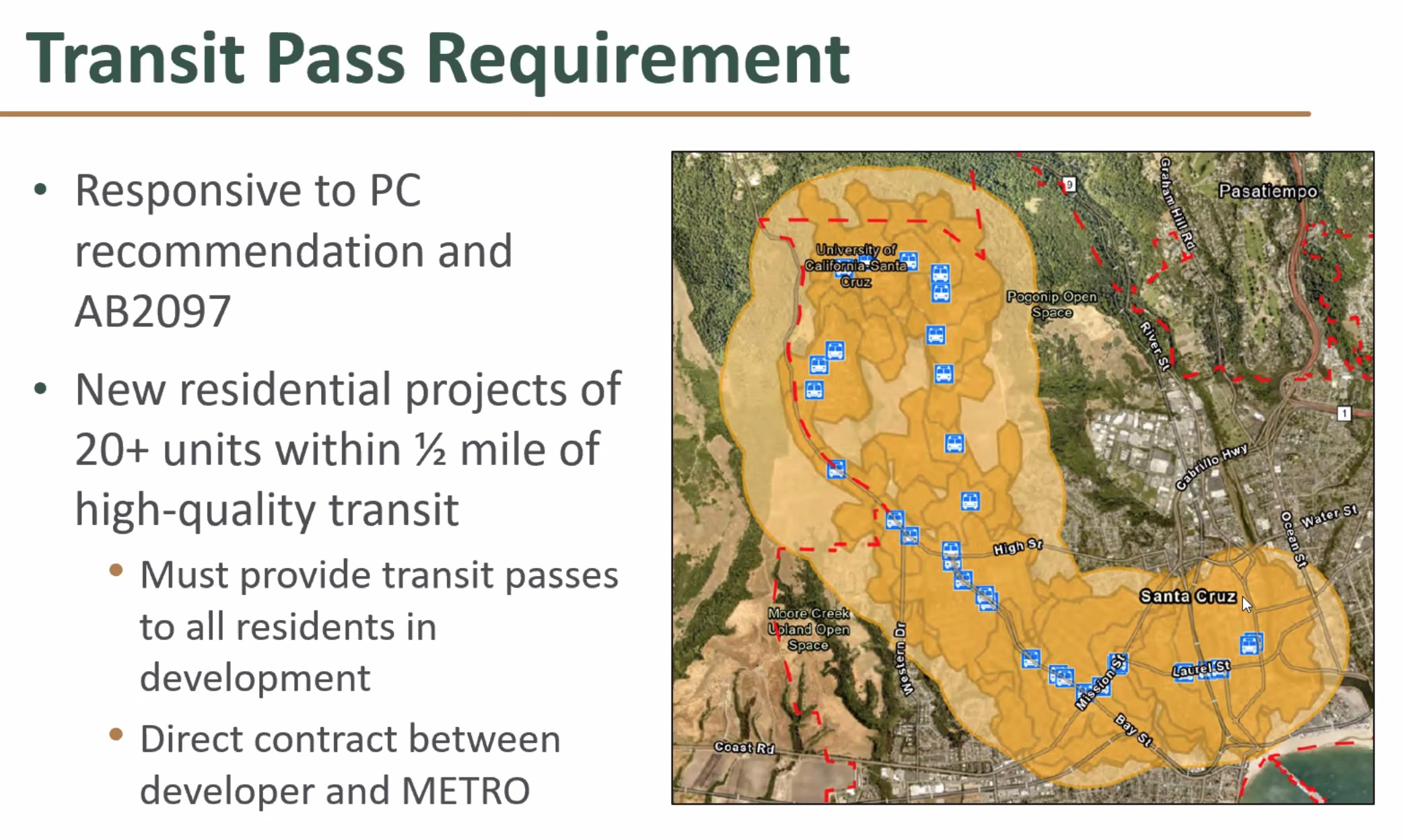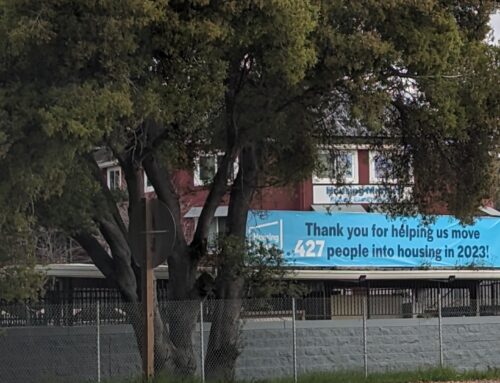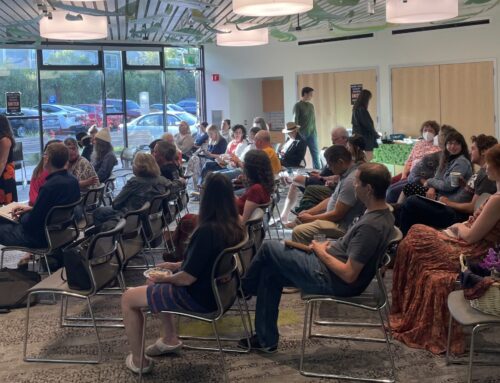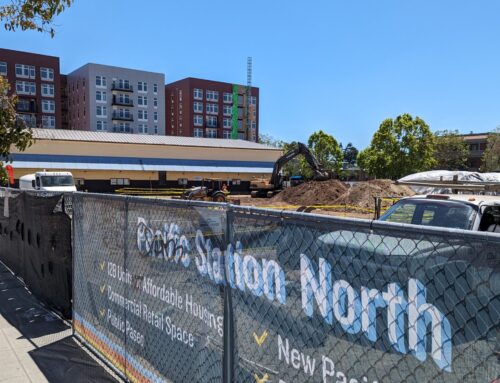
The Santa Cruz City Council approved objective design standards for new multi-family housing developments. (Kara Meyberg Guzman — Santa Cruz Local file)
SANTA CRUZ >> The Santa Cruz City Council approved objective design standards Tuesday night that will guide the development of multi-family housing.
Under the new rules:
- Multifamily developments in mixed-use or commercial districts with fewer than 50 units that fully conform to the city’s objective standards will be approved by staff rather than a public hearing. Developments that deviate from the city’s standards, or have more than 50 units will receive a public hearing.
- All new housing developments within a half-mile of a bus stop that have 20 or more units will be required to provide Santa Cruz Metro bus passes or other transit passes for all residents.
- A block of homes near Dakota and May avenues slated for higher density mixed-use commercial development under the city’s General Plan will remain zoned as medium-density residential development.
What are objective design standards?
Objective standards have been in development since 2019. In 2020, state law SB 330 began to limit cities from using subjective standards to evaluate housing proposals.
For example, a city council cannot require fewer units in a project because the council says the project doesn’t fit neighborhood aesthetics. The law encourages cities to create objective design standards because councils have to point to a specific objective design standard to reduce housing units in a project.
The rules contain hundreds of objective standards regulating parking, open space, building length, landscaping and other details.
Public meeting requirements
Because state law requires city leaders to approve housing projects that meet the objective standards, city staff have recommended approval of some design permits for housing developments without a public hearing. Most large developments automatically trigger a public hearing due to density-bonus requests, coastal permits, or other factors, said Santa Cruz Senior Planner Sarah Neuse.
At previous meetings, some residents have argued against administrative approval and in favor of automatic public hearings.
Staff presented three alternatives for the approval of design permits of residential and mixed-use projects in commercial or mixed-use zones:
- Option 1: In a streamlined approach recommended by staff and the planning commission, projects that fully conform to all the city’s requirements wouldn’t need a public hearing and could be approved by staff.
- Option 2: Projects with zero to five variations from the objective standards would trigger a public hearing with the Zoning Administrator. Projects proposing six or more variations would trigger a public hearing before the Planning Commission.
- Option 3: Under a third hybrid option, projects that meet the city’s objective standards and have 50 or fewer units could be approved by staff. Projects with more than 50 units would receive a public hearing.
Santa Cruz Senior Planner Sarah Neuse urged the council to approve the first option to incentivize developers to fully conform with the city’s standards, rather than propose plans that vary from the standards.
In response to community concerns about the transparency of development decisions, the council voted 5-2 to adopt the third, hybrid option.
“I would have even voted for the streamlined option one, because I really feel that would have given the most local control,” said Santa Cruz Mayor Sonja Brunner. “It’s very clear that our community wants more control, and this is the way to get there.”
Councilmembers Justin Cummings and Sandy Brown voted against the hybrid option. Cummings said he supported public hearings for all developments. “The developers are the ones who are looking for a fast approval process, not the community,” he said. “If we want to have more transparency, we really need to make sure that that option is available to people.”
Under state law, local governments have limited power to influence proposals that meet the city’s objective standards. For these proposals, local governments’ can only consider whether projects meet the city’s objective standards and its General Plan. If so, the project must be approved.
For proposals that have some variations from the objective standards, local decision makers must “consider the goal of the standard and compare the alternative design to that stated goal and determine that the goal is also met by the alternative design,” according to the staff report.
Bus pass requirements
As part of the new rules, developers of residential projects with 20 or more units that are within a half-mile of a “high-quality” bus stop will be required to provide free bus passes for all residents. High quality bus stops are defined by the frequency of bus service.

A city map shows some areas within a half-mile of a high-quality bus stop. In these areas, developers of housing projects with 20 or more units will be required to provide all residents with free METRO passes. (City of Santa Cruz)
Based on current bus routes, the rule will apply to the upper Westside and most of Downtown. Developers will be required to negotiate a contract with Santa Cruz Metro for the passes.
The requirement is spurred both by a recommendation from the Planning Commission and by a recently-passed state law, AB 2097, that prohibits cities from imposing parking requirements on residential developments of 20 or more units within a half-mile of public transit.
Land exemptions
The council also voted to exempt four parcels near May Avenue and Leonard Street from planned changes to the zoning code. City staff wanted to match local zoning to the higher density allowed by the city’s General Plan.
California law states that if a city’s General Plan and its zoning laws do not align, the rules that allow greater density apply.
For four parcels on Leonard Street, the changes would make the residential neighborhood open to commercial and mixed-use development, including hotels and motels.
At Tuesday night’s meeting, several Leonard Street residents said the neighborhood’s rezoning could displace longtime residents and change the neighborhood’s character.
Resident Kevin Stierhoff said that when the General Plan was adopted in 2012, the neighborhood wasn’t aware of the plan’s potential impacts. “The changes were subtle and obscure enough that even our most involved and diligent neighbors are not aware that the land use designation on these parcels had been changed,” he said. “If they had, they would have tried to address this sooner.”
If the city doesn’t permit the housing density allowed in the General Plan on Leonard Street, it must find another place in the city to permit an equal amount of housing. Councilmember Donna Meyers said staff should try to use the Ocean Street Plan, the Housing Element update, and the downtown expansion plan to reallocate the housing density. After meeting with some residents in the neighborhood and consulting with staff, Meyers said she believes the designation of the neighborhood for mixed-use and commercial development was “a mistake.”
The council voted unanimously to:
- Remove the four Leonard Street parcels from amendments to the zoning maps.
- Direct staff to create a plan to relocate the lost residential density elsewhere in the city.
- Return with a schedule for implementing the plan at the city council’s Jan. 24 meeting.
Cummings, Brown propose alternate plan
The council voted 5-2 to introduce ordinances that will:
- Approve the objective standards.
- Change the zoning code for some city parcels to conform with the city’s General Plan.
- Establish a new in-lieu fee for street tree removals.
- Establishing new requirements for the removal of a heritage tree or heritage shrub.
The second reading and adoption of these ordinances will take place at the next city council meeting. The city will begin to implement the new rules in January 2023.
Cummings and Brown opposed the new rules. Cummings presented an alternate proposal that would have:
- Increased the city’s inclusionary requirement for affordable housing for projects that receive a density bonus. A density bonus allows a development to be larger than normally allowed, and bypass other city regulations, if the project contains a certain number of affordable housing units. The city currently has a 20% inclusionary requirement. Under the proposal, projects with a 30% density bonus would have a 25% inclusionary requirement. Projects with a 50% density bonus would have a 30% inclusionary requirement. The Santa Cruz Planning Commission recommended these changes in June.
- Required new developments to replace any affordable housing units they displace, and for city staff to verify the affordability of any displaced units.
- Directed staff to consider making the city liable for damage to private property from street trees.
- Directed staff not to change zoning along major transportation corridors except to conform with the General Plan.
Cummings said the staff’s recommendations did not adequately address the city’s need for more affordable housing. “We provide direction and sometimes the city staff acts on it, and sometimes they don’t. And that’s why many people have had issues with trusting our city government,” Cummings said at Tuesday’s meeting.
Existing state laws require developers to replace any affordable units they displace, said principal planner Matt VanHua.
Councilmember Meyers echoed previous reports from city consultants that a higher inclusionary requirement could slow housing development in the city, including development of affordable units.
“Ratcheting up our inclusionary [requirement] is not necessarily going to result in any additional affordable housing,” Meyers said.
The alternate proposal failed with a 2-5 vote and Brown and Cummings in the minority.
Read related Santa Cruz Local stories
- Santa Cruz council delays vote on housing changes — Aug. 24, 2022
- Santa Cruz council aims for transparency with new state housing law – Sept. 9, 2021
- Racial exclusion, zoning and potential change in the city of Santa Cruz – March 13, 2021
- Housing design standards advance in Santa Cruz – March 10, 2021
- Where will new housing go in Santa Cruz? – Jan. 10, 2021
Questions or comments? Email [email protected]. Santa Cruz Local is supported by members, major donors, sponsors and grants for the general support of our newsroom. Our news judgments are made independently and not on the basis of donor support. Learn more about Santa Cruz Local and how we are funded.
Santa Cruz Local’s news is free. We believe that high-quality local news is crucial to democracy. We depend on locals like you to make a meaningful contribution so everyone can access our news. Learn about membership.
Jesse Kathan is a staff reporter for Santa Cruz Local through the California Local News Fellowship. They hold a master's degree in science communications from UC Santa Cruz.





